The Employee Advocacy Software Market is estimated to be valued at USD 523.7 million in 2025 and is projected to reach USD 1184.1 million by 2035, registering a compound annual growth rate (CAGR) of 8.5% over the forecast period.
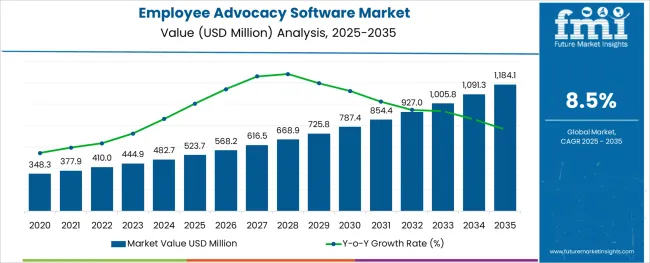
The employee advocacy software market is witnessing sustained momentum as enterprises increasingly recognize the value of leveraging their workforce to amplify brand visibility, enhance organic reach, and foster authentic engagement across digital platforms. The rising importance of personal branding and the role of employees as brand ambassadors have encouraged organizations to adopt structured advocacy programs supported by dedicated software solutions.
Current market conditions indicate steady growth, propelled by the integration of analytics, content curation tools, and social media management features within these platforms, which allow businesses to measure program effectiveness and optimize engagement strategies. Looking ahead, favorable demand is expected as remote and hybrid work models persist, prompting businesses to strengthen internal communication and employee engagement through digital advocacy initiatives.
The proliferation of influencer marketing practices and the growing emphasis on earned media value further contribute to this positive outlook. The market is well-positioned to expand as organizations prioritize tools that help humanize their brand messaging and drive trusted customer interactions through their existing workforce.
The market is segmented by Type and Application and region. By Type, the market is divided into On-Premises and Cloud Based. In terms of Application, the market is classified into SMEs and Large Enterprises. Regionally, the market is classified into North America, Latin America, Western Europe, Eastern Europe, Balkan & Baltic Countries, Russia & Belarus, Central Asia, East Asia, South Asia & Pacific, and the Middle East & Africa.
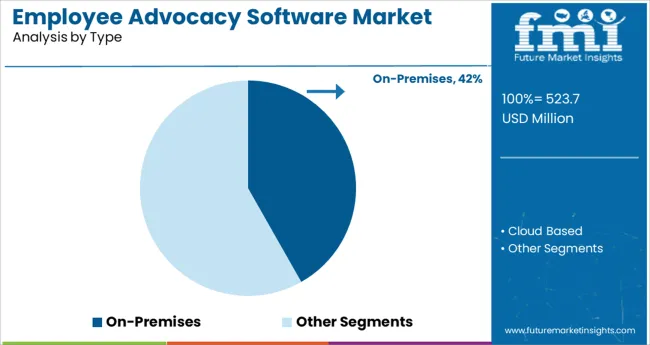
The on-premises segment accounted for approximately 41.8% of the employee advocacy software market share, maintaining a strong position within the type category. Its sustained relevance is driven by organizations seeking greater control over data security, customization, and system integration, particularly in highly regulated industries such as finance, healthcare, and government services.
Enterprises with strict compliance requirements continue to prefer on-premises deployment models to mitigate cybersecurity risks and ensure adherence to internal IT governance protocols. Although cloud-based solutions have gained significant traction, the on-premises segment benefits from established infrastructure and long-term licensing arrangements that reduce operational disruptions.
The segment’s performance is further reinforced by enterprises valuing the ability to tailor platform functionalities to meet specific workflow and reporting needs. As digital advocacy programs scale in complexity and scope, organizations opting for on-premises solutions prioritize enhanced privacy measures and dedicated technical support. The segment is expected to retain a consistent presence, particularly among large, security-sensitive businesses, while experiencing gradual updates through hybrid deployment models.
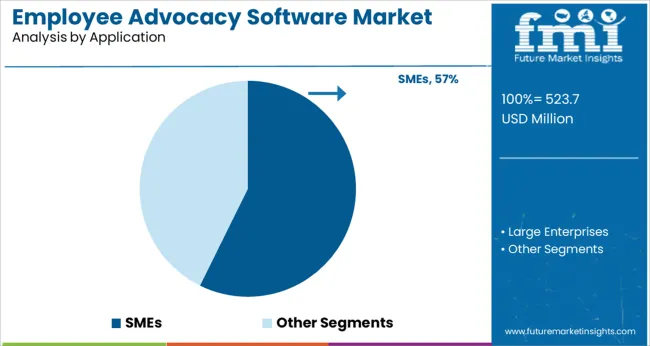
Within the application category, the SMEs segment led with a 57.3% market share, reflecting the growing adoption of employee advocacy software among small and medium-sized enterprises seeking to amplify brand reach without substantial marketing budgets. The segment’s dominance is attributed to the rising emphasis on social selling, peer recommendations, and authentic content sharing, which provide SMEs with a competitive edge in attracting prospects and nurturing customer relationships.
Employee advocacy software offers SMEs scalable, cost-effective solutions that help extend their digital footprint and build community engagement through their workforce. The market has observed increased interest from startups and mid-sized companies aiming to humanize brand messaging and improve recruitment visibility via employee-driven content.
Flexible pricing models and the availability of cloud-based platforms have further simplified adoption for resource-constrained businesses. Moving forward, the SMEs segment is projected to maintain strong growth momentum as social media platforms evolve, and smaller enterprises increasingly integrate advocacy initiatives into their broader digital marketing strategies to drive organic traffic and brand loyalty.
Increasing adoption of Employee Advocacy Software Tools Boosting prospects
Employee advocacy software enables companies to engage their workforce to share branded content and information via social channels. With these tools, brands are able to build pre-approved content libraries for their employees to access to share via mobile, email, or social media.
These tools not only help broaden a company's social presence by engaging its employees, but they also allow social media managers to have more control over the company's voice and messaging on social channels.
In addition, employee advocacy tools often play a part in companies’ social selling strategies, enabling sales representatives to effectively communicate with prospects and customers on social channels. Many of these tools offer gamification features to promote a higher volume of sharing amongst employees. All aforementioned factors are expected to propel the market growth during the forecast period.
Further, providing social integrations to allow the company's employees to share messaging and/or content directly from the platform is anticipated to be another factor boosting the growth of the market over the analysis period.
There has been a massive adoption of advanced employee advocacy software tools among organizations, which provides helpful as well as knowledgeable customer support. Companies’ employees are using these tools to share relevant stories and content to share with their followers.
The advocacy software provides a simple and intuitive interface, which is easy to use for users and admins. The advocacy tools streamline and simplify managing the social sharing of employee advocates and allow for posts to be set up in advance with the help of features including scheduling functionality.
The employee advocacy software offers advanced features such as quick and effective communication for international teams, allowance for separate leader boards, streams, and accounts, engaging gamification for employees, easy-to-use templates, and targeted message customization, among others. All these factors are expected to augment the growth of the Employee Advocacy Software Market over the analysis period.
The absence of a Solid Social Media Policy hampers Market Growth
The reason a lot of companies shy away from employee advocacy is the fear of letting everyone loose on social media to communicate. Icons for social media platforms such as Facebook, LinkedIn, and Twitter appear on all posts, which can be confusing for employees who are supposed to share that content on specific platforms rather than all three.
There is an absence of solid social media policy in Employee advocacy tools, due to which employees are not able to read, sign and fully understand the guidelines which have been set. These factors are expected to restrain the market growth during the forecast period.
Lack of Proper Setup Features to Impede Market Growth
Factors such as the lengthy and complicated initial team setup of the employee advocacy tools and the high cost of setting up the software are expected to hamper the market growth. In terms of functionality, the back end of the platform is complicated and difficult for some users to manage.
Messages on the employee advocacy tools come from one email address, which cannot be changed, along with the presence of occasional bugs and glitches that impact the connectivity of the software.
Some employee advocacy tools are slow for browsing and are buggy at times, and the platforms do not automatically post at optimized times for maximum attention, which varies for different social media channels. All these factors are expected to hinder the growth of the employee advocacy software market during the forecast period.
Increase in employee engagement among organizations to fuel the market growth
Key factors such as quick and simple communication of new information, without sending loads of emails, and increased employee engagement relative to sharing the company’s original and curated content by allowing them to share easily are expected to accelerate the growth of the Employee Advocacy Software market over the analysis period.
In addition, the employee advocacy software offers sharing of curated content, coupled with personalization as well as customization of content, which is also expected to drive market growth.
Features such as recommendation times during the week to post content on social media, to get the best engagement, flexible scheduling for social media plug-ins, easy interface for users, and effective and robust analytics reporting will augment the market growth in the forthcoming years.
A cloud-based segment to witness considerable CAGR for the market growth
The cloud-based type of the Employee Advocacy Software Market accounts for the highest CAGR of 8.3% during the forecast period. Under type segment, cloud-based type of Employee Advocacy Software will dominate the market over the forecast period, as the cloud technology provides better flexibility, a high degree of security, and a level of control and it is also a cost-effective solution.
The Cloud-based type helps businesses to accomplish cross-channel communication with their customers, enabling them to send information via emails, text messages, push alerts, in-app, and web notifications, as well as on-site warnings. It can also be used to share online and offline reviews as well as feedback reports with customers.
Large Enterprises segment to hold Considerable Sway
The large enterprise segment of the Employee Advocacy Software Market accounts for the highest CAGR of 8.1% during the forecast period, attributed to the increasing demand, particularly from this segment.
Owing to the high number of employees working in large enterprises, there has been an increasing demand for employee advocacy software in such organizations. The advocacy software helps employees (a vast number) in large enterprises to communicate easily and enables them to share their views on a particular matter.
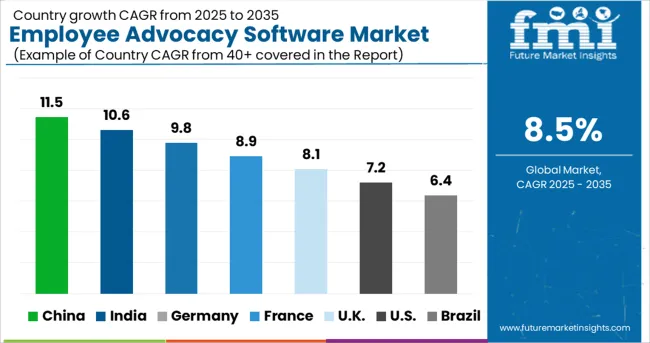
Adoption of new technology to Widen the Scope of market
North America is expected to dominate the employee advocacy software market, owing to the immediate adoption of new and emerging technologies and the presence of significant market players in the region.
The USA is expected to hold a significant position in the employee advocacy software market, experiencing a CAGR of 8.3% during the forecast period, and is expected to reach USD 322.5 Million.
Employee Advocacy Software Market in China and Japan to Witness Better Growth Opportunities
The Asia Pacific region is expected to grow at a significant CAGR during the forecast period, owing to the growing adoption of employee advocacy software in the region. The growing awareness for enhancing employee experience in key countries, such as China, and Japan is expected to fuel the adoption of employee advocacy software in the APAC region.
China is expected to represent the highest CAGR of 7.7% in the employee advocacy software market during the forecast period and is expected to reach USD 67.6 Million during the forecast period. On the other hand, Japan is expected to represent the highest CAGR of 6.8% in the employee advocacy software market during the forecast period and is expected to reach USD 55.4 Million during the forecast period.
DrumUp, Hootsuite, Bambu, GaggleAMP, Influitive, EveryoneSocial, Sociabble, PostBeyond, Dynamic Signal, Smarp, ClearView, MarketBeam, SocioAdvocacy, Ambassify, and RFactr, among others are the top companies in the global Employee Advocacy Software Market.
With a sizable employee advocacy software market share, these main firms are concentrating on growing their consumer base in new countries. These businesses are making use of strategic collaboration initiatives to grow their market share and profits.
Mid-size and smaller businesses, on the other hand, are expanding their market presence by gaining new contracts and entering new markets, thanks to technical developments and product innovations.
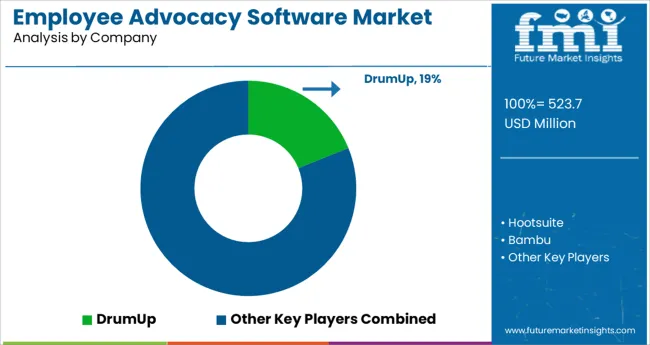
The global employee advocacy software market is estimated to be valued at USD 523.7 million in 2025.
It is projected to reach USD 1,184.1 million by 2035.
The market is expected to grow at a 8.5% CAGR between 2025 and 2035.
The key product types are on-premises and cloud based.
smes segment is expected to dominate with a 57.3% industry share in 2025.






Full Research Suite comprises of:
Market outlook & trends analysis
Interviews & case studies
Strategic recommendations
Vendor profiles & capabilities analysis
5-year forecasts
8 regions and 60+ country-level data splits
Market segment data splits
12 months of continuous data updates
DELIVERED AS:
PDF EXCEL ONLINE
Employee Engagement Market Size and Share Forecast Outlook 2025 to 2035
Employee Recognition Software Market Analysis - Size, Share, and Forecast 2025 to 2035
Ex-Employee Verification Market Size and Share Forecast Outlook 2025 to 2035
Social Employee Recognition System Market Size, Growth, and Forecast for 2025 to 2035
Social Employee Recognition System Market in Korea – Industry Outlook & Forecast 2025 to 2035
Social Employee Recognition System Market in Japan - Growth & Forecast 2025 to 2035
North America Employee Recognition Software Market – Growth & Outlook 2025 to 2035
Western Europe Social Employee Recognition System Market - Trends & Forecast 2025 to 2035
Online Advocacy Platform Market
Customer Advocacy Software Market - Enhancing Brand Loyalty
Software-Defined Wide Area Network Market Size and Share Forecast Outlook 2025 to 2035
Software Defined Vehicle Market Size and Share Forecast Outlook 2025 to 2035
Software Defined Networking (SDN) And Network Function Virtualization (NFV) Market Size and Share Forecast Outlook 2025 to 2035
Software Defined Perimeter (SDP) Market Size and Share Forecast Outlook 2025 to 2035
Software-Defined Wide Area Network SD-WAN Market Size and Share Forecast Outlook 2025 to 2035
Software Defined Radio (SDR) Market Size and Share Forecast Outlook 2025 to 2035
Software License Management (SLM) Market Size and Share Forecast Outlook 2025 to 2035
Software-Defined Networking SDN Market Size and Share Forecast Outlook 2025 to 2035
Software-Defined Anything (SDx) Market Size and Share Forecast Outlook 2025 to 2035
Software-Defined Data Center Market Size and Share Forecast Outlook 2025 to 2035

Thank you!
You will receive an email from our Business Development Manager. Please be sure to check your SPAM/JUNK folder too.
Chat With
MaRIA